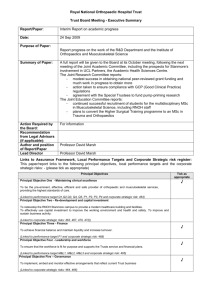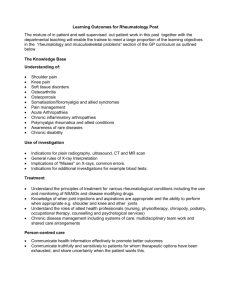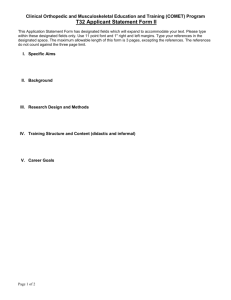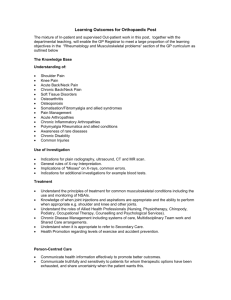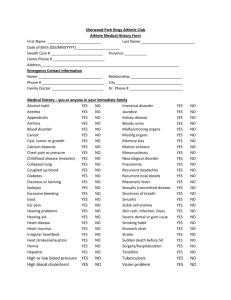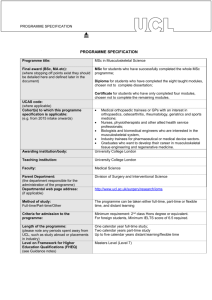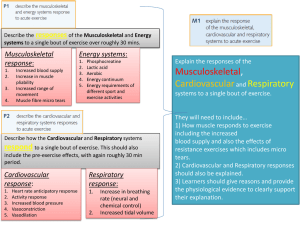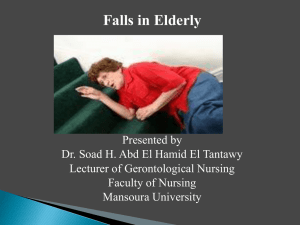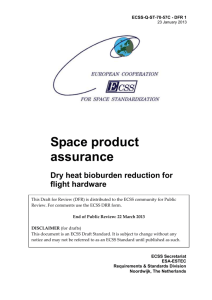Standards for human musculoskeletal tissue
advertisement
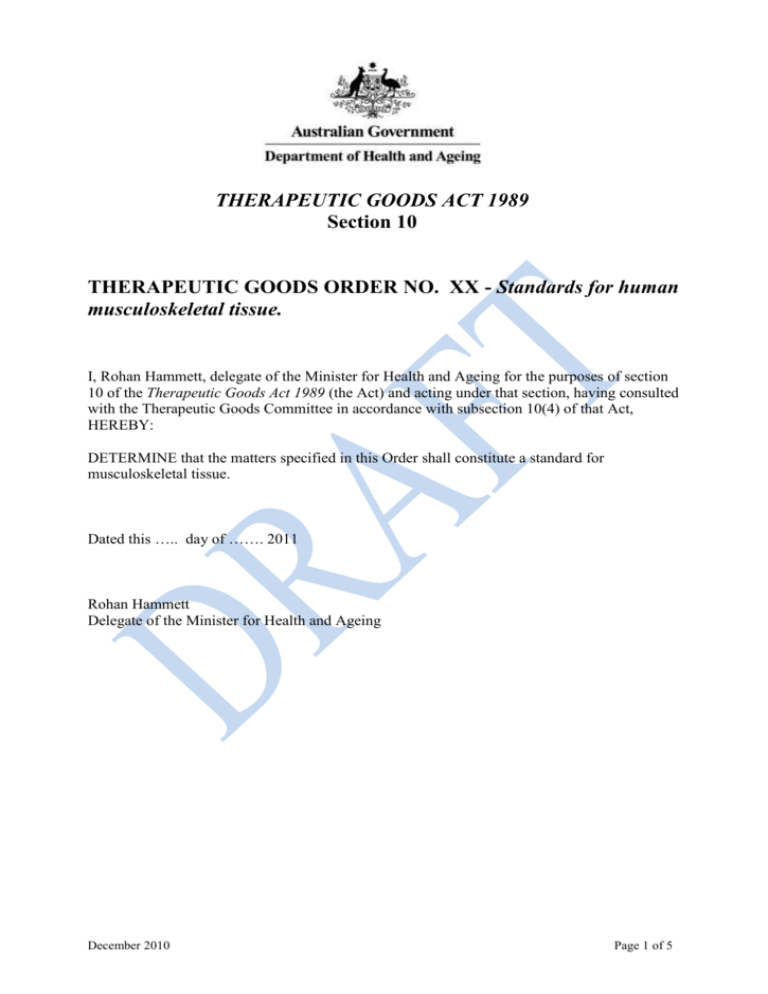
THERAPEUTIC GOODS ACT 1989 Section 10 THERAPEUTIC GOODS ORDER NO. XX - Standards for human musculoskeletal tissue. I, Rohan Hammett, delegate of the Minister for Health and Ageing for the purposes of section 10 of the Therapeutic Goods Act 1989 (the Act) and acting under that section, having consulted with the Therapeutic Goods Committee in accordance with subsection 10(4) of that Act, HEREBY: DETERMINE that the matters specified in this Order shall constitute a standard for musculoskeletal tissue. Dated this ….. day of ……. 2011 Rohan Hammett Delegate of the Minister for Health and Ageing December 2010 Page 1 of 5 1. Name of Order This Order may be cited as Therapeutic Goods Order No. XX Standards for human musculoskeletal tissue. 2. Commencement This Order commences on the day after the day it is registered on the Federal Register of Legislative Instruments. 3. Purpose of this Order The purpose of this Order is to specify the minimum technical requirements for the safety and quality assurance for a biological that is a human musculoskeletal tissue. 4. Interpretation (1) For the purpose of this Order, the presence of the term “must” in relation to a particular requirement in a provision set out in this Order means that the requirement is to be complied with at all times. (2) In this Order: allogeneic use means the use of a biological that is removed from one person and applied to another. antimicrobial means the ability of a substance to kill or inhibit growth of microorganisms. aseptic technique means the technique that consists of measures used to prevent contamination by micro-organisms. autologous use means the use of a biological that is removed from and applied to the same person. bioburden has the same meaning as in “bioburden” in subsection 3(1) of the Therapeutic Goods Act 1989, as amended from time to time. biological has the same meaning as “biological” in subsection 3(1) of the Therapeutic Goods Act 1989 as amended from time to time. Note that “biological” under the Act means: (1) Subject to subsection (3), a biological is a thing that: (a) either: (i) comprises, contains or is derived from human cells or human tissues; or (ii) is specified under subsection (2); and (b) is represented in any way to be, or that is, whether because of the way in which it is presented or for any other reason, likely to be taken to be: (i) for use in the treatment or prevention of a disease, ailment, defect or injury affecting persons; or (ii) for use in making a medical diagnosis of the condition of persons; or (iii) for use in influencing, inhibiting or modifying a physiological process in persons; or (iv) for use in testing the susceptibility of persons to a disease or ailment; or December 2010 Page 2 of 5 (v) for use in the replacement or modification of parts of the anatomy in persons. (2) The Secretary may, by legislative instrument, specify things for the purposes of subparagraph (1)(a)(ii). (3) The Secretary may, by legislative instrument, determine that a specified thing is not a biological for the purposes of the Act; cell(s) means individual cells or a collection of cells when not bound by any form of connective tissue. collection means the process of removing a biological or a source of a biological from a donor. container has the same meaning as in “container” in subsection 3(1) of the Therapeutic Goods Act 1989 (the Act), as amended from time to time. critical material means all components, materials or supplies which could have a direct impact on the quality, safety and function of the end product. donor means every source, whether living or deceased, of blood, blood components, cells or tissues. manufacture has the same meaning as in ‘manufacture’ in subsection 3(1) of the Therapeutic Goods Act 1989, as amended from time to time. microbial means microorganisms including, but not limited to, bacteria, fungi, Mycoplasma and Rickettsia but does not include viruses or prions. minimal manipulation means a process involving any of the following actions: (a) centrifugation; (b) trimming, cutting or milling; (c) flushing or washing; (d) refrigeration; (e) freezing; (f) any similar thing to a thing mentioned in paragraph (a), (b), (c), (d) or (e). processing means any operation involved in the preparation, manipulation, preservation for storage and packaging of a biological. recipient means a person who receives blood, blood components, cells or tissues by infusion or implantation. specified microorganism means a microorganism which, if isolated from the tissue, necessitates discard of the tissue. storage means the process of maintaining a substance, material or product under appropriate controlled conditions. tissue means all constituent parts of the body formed by cells. transport means transfer within or between premises of a substance, material or product under appropriate controlled conditions. December 2010 Page 3 of 5 5. Application of this Order (1) (2) 6. The requirements of this Order apply to biologicals that are human musculoskeletal tissue, such as muscle, ligament, bone or cartilage, collected from (a) living human donors intended for autologous or allogeneic use; or (b) deceased human donors intended for allogeneic use. This Order specifies requirements for biological and other therapeutic goods that are critical materials used in the manufacture of biologicals in subsection 5(1). Exemptions (1) Biologicals exempt from the requirements set out under this Order are the following: (a) human musculoskeletal tissue that is a biological and to which an exemption from compliance with this Order in relation to the supply of the human musculoskeletal tissue has been granted by the Secretary in accordance with section 14 and 14A of the Act; and (b) musculoskeletal cells and tissue biopsied for the purpose of an in vitro diagnosis and not for manufacture and/or reintroduction or transplant to a recipient; and (c) human musculoskeletal tissue that is processed beyond minimal manipulation, including: (i) freeze-dried and/ or demineralised musculoskeletal tissue; or (ii) chondrocytes or other musculoskeletal cell or tissue types that are cultured or altered beyond minimal manipulation. 7. General Requirements (1) Critical materials in the collection and manufacture of musculoskeletal tissue must be of a design, composition, quality and safety to protect the quality and safety of the musculoskeletal tissue. (2) Musculoskeletal tissue that is to be transported to the manufacturing facility must be: (3) (a) packaged using aseptic technique with at least one moisture impermeable barrier and maintained at or below 8C prior to and during transportation; and (b) sampled prior to processing using a representative and validated sampling technique to collect surface microorganisms for bioburden determination. Musculoskeletal tissue that is not subjected to a bioburden reduction process must demonstrate no microbial growth when the representative samples are tested. If the same musculoskeletal tissue is subjected to further processing, repeat sampling for bioburden determination must be performed on that tissue. December 2010 Page 4 of 5 (4) Musculoskeletal tissue that is subjected to a bioburden reduction process must be sampled for bioburden determination to exclude tissue contaminated with specified microorganisms of clinical significance. (5) Where antimicrobial agents have been used in the bioburden reduction process on the musculoskeletal tissue, validation of bioburden test must include neutralisation of the antimicrobial agents present in the sample. (6) Further to subsection 7(4) and 7(5), the manufacturer must comply with the following additional requirements: (7) (a) written specifications for the tissue must include a list of microorganisms that which, if tested and found to be present in the tissue, will require rejection and discard of the tissue; and (b) repeat sampling and testing for bioburden must be performed on the tissue in circumstances where the human musculoskeletal tissue is subjected to further processing; and (c) where the musculoskeletal tissue has been subjected to a terminal bioburden reduction process, representative samples of musculoskeletal tissue must have no microbial growth when tested; and (d) if terminal sterilisation is performed on the musculoskeletal tissue, the manufacturing process must comply with the requirements of Annex 1 of the Code of GMP for Sterile Medicinal Products, available on the TGA website http://www.tga.gov.au/industry/manuf-pics-gmp-medicines.htm#technical. Musculoskeletal tissue must be sealed within a sterile container and at least double packaged so as to (a) prevent ingress/egress of material other than for a gas sterilant (if applicable) (b) ensure any breach of integrity will be evident. (8) Storage conditions for each type of musculoskeletal tissue must be established. Conditions for storage of musculoskeletal tissues must be (a) temporary storage at minus 20°C to minus 40°C for no more than 6 months; or (b) frozen and cryopreserved at less than minus 40°C for no more than 5 years; unless (c) other conditions are established based on data validated by the manufacturer, or documented evidence obtained from scientific literature; and (d) these temperatures must be maintained during transport. December 2010 Page 5 of 5
